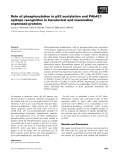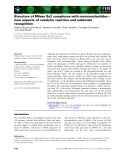
The complexity of recognition
-
DNA ligases are the enzymes responsible for the repair of single-strandedanddouble-strandednicks indsDNA.DNA ligases are structurally similar, possibly sharing a common molecular mechanism of nick recognition and ligation catalysis. This mechanism remains unclear, in part because the structure of ligase in complex with dsDNAhas yet to be solved.DNA ligases share common structural elementswith DNA polymerases, which have been cocrystallized with dsDNA. Based on the observed DNA polymerase–dsDNA interactions, we propose a mechanism for recognition of a single-stranded nick by DNA ligase....
 7p
7p  tumor12
tumor12
 22-04-2013
22-04-2013
 40
40
 2
2
 Download
Download
-
The ability of aminoacyl-tRNA synthetases to distinguish betweensimilaraminoacidsiscrucial foraccuratetrans-lation of the genetic code. Saccharomyces cerevisiae seryl-tRNA synthetase (SerRS) employs tRNA-dependent recognition of its cognate amino acid serine [Lenhard, B., Filipic, S., Landeka, I., Skrtic, I., So¨ll, D. & Weygand-Durasevic, I. (1997)J. Biol. Chem.272, 1136–1141]. Herewe show that dimeric SerRS enzyme complexed with one molecule of tRNA Ser is more specific and more efficient in catalyzing seryl-adenylate formation than the apoenzyme alone. ...
 9p
9p  tumor12
tumor12
 22-04-2013
22-04-2013
 38
38
 2
2
 Download
Download
-
A high-affinity monoclonal antibody (M27), raised against the human thrombin–antithrombin complex, has been identifiedand characterized. The epitope recognizedbyM27 was located to the linear sequence FIREVP (residues 411– 416), located in the C-terminal cleavage peptide of anti-thrombin.This regionoverlaps, by two residues, theputative binding site of antithrombin for the serpin–enzyme complex receptor.
 11p
11p  tumor12
tumor12
 20-04-2013
20-04-2013
 37
37
 4
4
 Download
Download
-
Several crystal andNMRstructures of calmodulin (CaM)in complex with fragments derived from CaM-regulated pro-teins have been reported recently and reveal novel ways for CaMto interact with its targets. This review will discuss and compare features of the interaction between CaM and its target domains derived from the plasma membrane Ca 2+ -pump, the Ca 2+ -activated K + -channel, the Ca 2+ / CaM-dependent kinase kinase and the anthrax exotoxin.
 11p
11p  tumor12
tumor12
 20-04-2013
20-04-2013
 26
26
 4
4
 Download
Download
-
It has been shown previously in various organisms that the peroxin PEX14 is a component of a docking complex at the peroxisomalmembrane,where it is involved in the import of matrix proteins into the organelle after their synthesis in the cytosol and recognition by a receptor. Here we present a characterization of theTrypanosoma bruceihomologue of PEX14. It is shown that the protein is associated with gly-cosomes,the peroxisome-like organelles of trypanosomatids in which most glycolytic enzymes are compartmentalized....
 9p
9p  fptmusic
fptmusic
 16-04-2013
16-04-2013
 46
46
 2
2
 Download
Download
-
The complex C1 triggers the activation of the Complement classical pathway through the recognition and binding of antigen–antibody complex by its subunit C1q. The globular region of C1q is responsible for C1 binding to the immune complex. C1q can also bind nonimmune molecules such as DNAand sulfated polysaccharides, leading either to the activation or inhibition of Complement. The binding site of these nonimmune ligands is debated in the literature, and it has beenproposed to be located either in the globular region or in the collagen-like regionof C1q, or inboth....
 7p
7p  fptmusic
fptmusic
 12-04-2013
12-04-2013
 40
40
 2
2
 Download
Download
-
The RNA recognition motif (RRM), also known as RNA-binding domain (RBD) or ribonucleoprotein domain (RNP) is one of the most abundant protein domains in eukaryotes. Based on the comparison of more than 40 structures including 15 complexes (RRM–RNA or RRM–protein), we reviewed the structure–function relationships of this domain. We identified and classified the different structural elements of the RRM that are import-ant for binding a multitude of RNA sequences and proteins.
 14p
14p  awards
awards
 06-04-2013
06-04-2013
 40
40
 2
2
 Download
Download
-
This minireview series examines the structural principles underlying the biological function of RNA-binding proteins. The structural work of the last decade has elucidated the structures of essentially all the major RNA-binding protein families; it has also demonstrated how RNA recognition takes place. The ribosome structures have further integrated this knowledge into principles for the assembly of complex ribonucleoproteins. Structural and biochemical work has revealed unexpectedly that several RNA-binding proteins bind to other proteins in addition to RNA or instead of RNA....
 10p
10p  awards
awards
 06-04-2013
06-04-2013
 47
47
 4
4
 Download
Download
-
Post-translational modifications, such as phosphorylation and acetylation of the tumour suppressor protein p53, elicit important effects on the func-tion and the stability of the resultant protein. However, as phosphorylation and acetylation are dynamic events subject to complex controls, elucidating the relationships between phosphorylation and acetylation is difficult.
 7p
7p  awards
awards
 06-04-2013
06-04-2013
 33
33
 3
3
 Download
Download
-
Eukaryotic initiation factor (eIF) 4B is part of the protein complex involved in the recognition and binding of mRNA to the ribosome. Drosophila eIF4Bis a single-copy gene that encodes two isoforms, termed eIF4B-L (52.2 kDa) and eIF4B-S (44.2 kDa), generated as a result of the alternative recognition of two polyadeynlation signals during tran-scription termination and subsequent alternative splicing of the two pre-mRNAs. Both eIF4B mRNAs and proteins are expressed during the entire embryogenesis and life cycle....
 14p
14p  dell39
dell39
 03-04-2013
03-04-2013
 36
36
 4
4
 Download
Download
-
trans-[PtCl2NH3(4-Hydroxymethylpyridine)] (trans-PtHMP) is an analogue of clinically ineffective transplatin, which is cytotoxic in the human leuke-mia cancer cell line. As DNA is a major pharmacological target of anti-tumor platinum compounds, modifications of DNA by trans-PtHMP and recognition of these modifications by active tumor suppressor protein p53 were studied in cell-free media using the methods of molecular biology and biophysics.
 14p
14p  dell39
dell39
 27-03-2013
27-03-2013
 49
49
 4
4
 Download
Download
-
The crystal structure ofPterocarpus angolensislectin is determined in its ligand-free state, in complex with the fucosylated biantennary complex type decasaccharide NA2F, and in complex with a series of smaller oligosaccha-ride constituents of NA2F. These results together with thermodynamic binding data indicate that the complete oligosaccharide binding site of the lectin consists of five subsites allowing the specific recognition of the penta-saccharide GlcNAcb(1–2)Mana(1–3)[GlcNAcb(1–2)Mana(1–6)]Man. ...
 14p
14p  inspiron33
inspiron33
 26-03-2013
26-03-2013
 54
54
 5
5
 Download
Download
-
The inner face of the nuclear envelope of metazoan cells is covered by a thin lamina consisting of a one-layered network of intermediate filaments inter-connecting with a complex set of transmembrane proteins and chromatin associating factors. The constituent proteins, the lamins, have recently gained tremendous recognition, because mutations in the lamin A gene,
 8p
8p  galaxyss3
galaxyss3
 21-03-2013
21-03-2013
 32
32
 3
3
 Download
Download
-
The crystal structure of aThermoactinomyces vulgariscyclo⁄maltodextrin-binding protein (TvuCMBP) complexed withc-cyclodextrin has been deter-mined. LikeEscherichia colimaltodextrin-binding protein (EcoMBP) and other bacterial sugar-binding proteins,TvuCMBP consists of two domains, an N- and a C-domain, both of which are composed of a centralb-sheet surrounded bya-helices; the domains are joined by a hinge region contain-ing three segments.
 12p
12p  galaxyss3
galaxyss3
 19-03-2013
19-03-2013
 48
48
 5
5
 Download
Download
-
We have shown that hormone-induced downregulation of luteinizing hor-mone receptor (LHR) in the ovary is post-transcriptionally regulated by an mRNA binding protein. This protein, later identified as mevalonate kinase (MVK), binds to the coding region of LHR mRNA, suppresses its transla-tion, and the resulting ribonucleoprotein complex is targeted for degrada-tion.
 11p
11p  galaxyss3
galaxyss3
 07-03-2013
07-03-2013
 29
29
 5
5
 Download
Download
-
The tumor suppressor von Hippel–Lindau (VHL) gene product forms a com-plex with elongin B and elongin C, and acts as a recognition subunit of a ubiquitin E3 ligase. Interactions between components in the complex were investigated in living cells by fluorescence resonance energy transfer (FRET)–fluorescence lifetime imaging microscopy (FLIM).
 9p
9p  media19
media19
 04-03-2013
04-03-2013
 42
42
 2
2
 Download
Download
-
The pseudouridine synthase and archaeosine transglycosylase (PUA) domain is a compact and highly conserved RNA-binding motif that is widespread among diverse types of proteins from the three kingdoms of life. Its three-dimensional architecture is well established, and the structures of several PUA–RNA complexes reveal a common RNA recognition sur-face, but also some versatility in the way in which the motif binds to RNA.
 13p
13p  media19
media19
 04-03-2013
04-03-2013
 33
33
 2
2
 Download
Download
-
Many protein substrates of caspases are cleaved at noncanonical sites in comparison to the recognition motifs reported for the three caspase sub-groups. To provide insight into the specificity and aid in the design of drugs to control cell death, crystal structures of caspase-7 were determined in complexes with six peptide analogs (Ac-DMQD-Cho, Ac-DQMD-Cho, Ac-DNLD-Cho, Ac-IEPD-Cho, Ac-ESMD-Cho, Ac-WEHD-Cho) that span the major recognition motifs of the three subgroups.
 14p
14p  media19
media19
 04-03-2013
04-03-2013
 38
38
 4
4
 Download
Download
-
The twin arginine translocation (Tat) system transports folded proteins across the bacterial plasma membrane. In Gram-negative bacteria, mem-brane-bound TatABC subunits are all essential for activity, whereas Gram-positive bacteria usually contain only TatAC subunits.
 12p
12p  vinaphone15
vinaphone15
 27-02-2013
27-02-2013
 41
41
 3
3
 Download
Download
-
Although the mechanism of RNA cleavage by RNases has been studied for many years, there remain aspects that have not yet been fully clarified. We have solved the crystal structures of RNase Sa2 in the apo form and in complexes with mononucleotides. These structures provide more details about the mechanism of RNA cleavage by RNase Sa2.
 13p
13p  vinaphone15
vinaphone15
 25-02-2013
25-02-2013
 31
31
 1
1
 Download
Download
CHỦ ĐỀ BẠN MUỐN TÌM



















![Báo cáo khoa học: Recognition of DNA modified by trans-[PtCl2NH3(4hydroxymethylpyridine)] by tumor suppressor protein p53 and character of DNA adducts of this cytotoxic complex Báo cáo khoa học: Recognition of DNA modified by trans-[PtCl2NH3(4hydroxymethylpyridine)] by tumor suppressor protein p53 and character of DNA adducts of this cytotoxic complex](https://tailieu.vn/image/document/thumbnail/2013/20130327/dell39/135x160/9041364380424.jpg)













